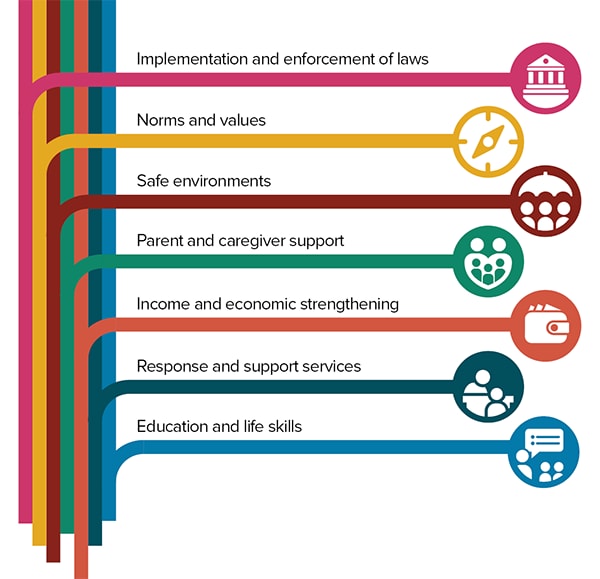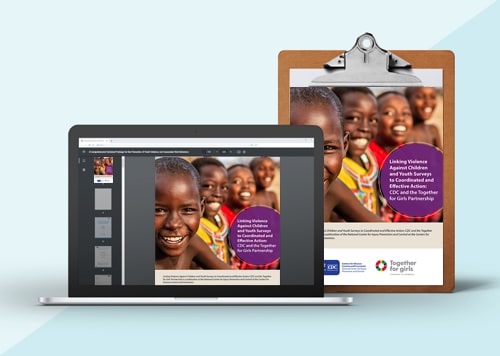Preventing Violence Against Children and Youth Globally
Violence against children and youth is common globally. An estimated 1 billion children—half of all the children in the world—are victims of violence every year.
Violence against children and youth is costly. The economic impact of violence against children and youth is estimated at hundreds of billions of dollars per year.
Children and youth often experience more than one form of violence. In Tanzania, for example, more than 80% of adolescent males and females aged 13 to 24 years who experienced sexual abuse as a child also experienced physical violence.
Girls and young women are more vulnerable to sexual violence. Between 11% and 26% of adolescent girls and young women in sub-Saharan African countries that completed a Violence Against Children and Youth Survey (VACS) experienced sexual violence in the past 12 months. For 7%–55% of adolescent girls and young women who ever had sex, their first sexual experience was forced or coerced, increasing their risk for HIV infection.

Violence against children and youth can lead to lifelong health problems. Children who experience violence have higher risks for health and social problems, such as chronic disease, HIV, mental health issues, substance misuse, and reproductive health problems. Violence also leads to continued cycles of violence, as young people who experience violence are more likely to perpetrate violence against others later in life.
Violence and other adverse childhood experiences (ACEs) increase the risk of sexual risk-taking behaviors and HIV. For example, in Malawi, children exposed to violence were less likely to use condoms as young adults, increasing their risk for HIV infection.
Violence Against Children and Youth Surveys (VACS), led by CDC as part of the Together for Girls partnership, are nationally representative household surveys designed to measure how much and how often physical, emotional, and sexual violence against children and youth occurs globally. Males and females age 13 to 24 participate in the survey. The survey also captures information about risk and protective factors, as well as the impact of violence. Findings from VACS provide reliable evidence to enable countries to make better decisions about allocating limited resources to develop, launch, and evaluate violence prevention programs and child protection systems.
For VACS, females and males aged 13 to 24 years old are interviewed about whether they ever experienced sexual, physical, or emotional violence. They also provide information about recent experiences of violence, within the last 12 months. All data for the VACS are collected through an in-person interview with trained interviewers.
VACS measures how much and how often sexual, physical, and emotional violence against children and youth occurs. VACS also measures exposure to violence in the home, both towards siblings and through witnessing domestic violence. Witnessing violence in the community is also assessed. VACS also includes questions about where violence happens, risk, and protective factors. The survey also includes education and economic information, health and wellness, and other factors about the experiences of children and youth.
Violence is preventable. A first step in preventing violence globally is understanding how much it happens, where it occurs, and its impacts on the health and well-being of children and youth. High-quality, timely data on violence provides critical information to develop prevention strategies based on the best available evidence on what works to stop the violence.
INSPIRE: Seven Strategies for Ending Violence Against Children is a group of strategies distilled from the best available evidence and with the greatest potential to reduce violence against children and youth. The INSPIRE document provides an overview of effective and promising programs and strategies to end violence. The INSPIRE Handbook: action for implementing the seven strategies for ending violence against children includes guidance on planning to implement interventions to prevent violence. The INSPIRE Indicator Guidance and Results Framework provides a model to track and monitor progress results. Additionally, there is an INSPIRE training, which provides individuals with the opportunity to learn more about evidence-based strategies and approaches to preventing and responding to violence against children.


Linking Violence Against Children and Youth Surveys to Coordinated and Effective Action: CDC and the Together for Girls Partnership [4.30 MB, 30 Pages, Print Only] is a guide for countries interested in undertaking VACS and supporting data-informed actions to address the burden and consequences of violence against children and youth.